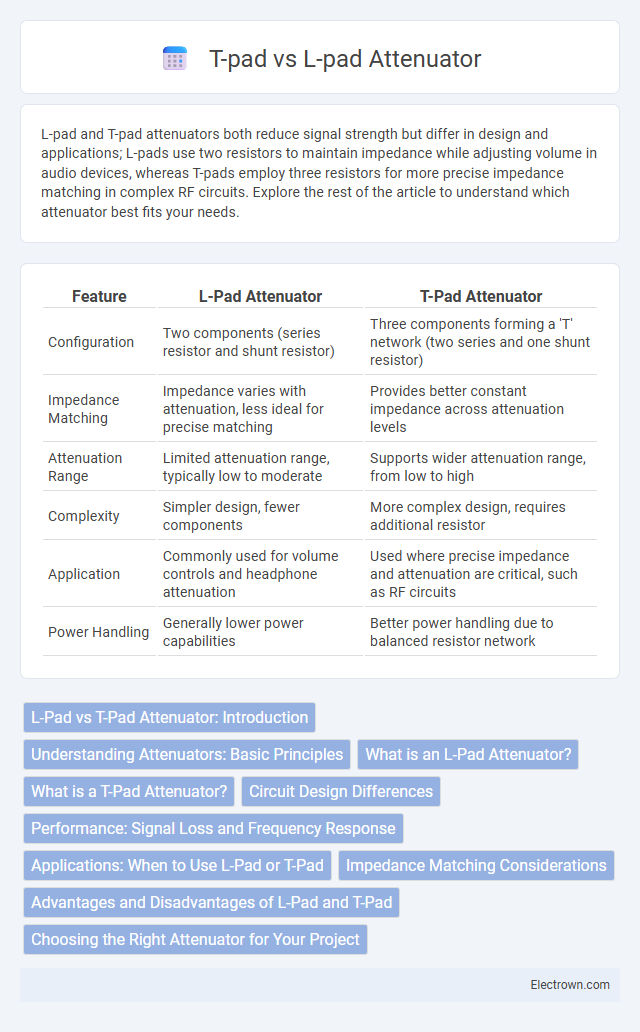L-pad and T-pad attenuators both reduce signal strength but differ in design and applications; L-pads use two resistors to maintain impedance while adjusting volume in audio devices, whereas T-pads employ three resistors for more precise impedance matching in complex RF circuits. Explore the rest of the article to understand which attenuator best fits your needs.
Table of Comparison
| Feature | L-Pad Attenuator | T-Pad Attenuator |
|---|---|---|
| Configuration | Two components (series resistor and shunt resistor) | Three components forming a 'T' network (two series and one shunt resistor) |
| Impedance Matching | Impedance varies with attenuation, less ideal for precise matching | Provides better constant impedance across attenuation levels |
| Attenuation Range | Limited attenuation range, typically low to moderate | Supports wider attenuation range, from low to high |
| Complexity | Simpler design, fewer components | More complex design, requires additional resistor |
| Application | Commonly used for volume controls and headphone attenuation | Used where precise impedance and attenuation are critical, such as RF circuits |
| Power Handling | Generally lower power capabilities | Better power handling due to balanced resistor network |
L-Pad vs T-Pad Attenuator: Introduction
L-pad and T-pad attenuators serve distinct roles in controlling signal levels within audio and RF circuits. L-pad attenuators consist of two resistors arranged to maintain a constant impedance while varying attenuation, ideal for matching impedances in speaker drivers or headphones. T-pad attenuators use three resistors, providing balanced attenuation with consistent impedance on both input and output, making them suitable for more complex signal matching and noise reduction tasks.
Understanding Attenuators: Basic Principles
L-pad and T-pad attenuators both reduce signal strength without significantly distorting the audio waveform but differ in design and application. An L-pad consists of two resistors arranged to maintain impedance while attenuating, ideal for matching lines with known impedance loads. T-pad attenuators use three resistors in a T configuration providing balanced attenuation and better isolation for complex impedance matching in audio and RF systems.
What is an L-Pad Attenuator?
An L-pad attenuator is a two-element passive network comprising a series resistor and a shunt resistor designed to reduce signal strength while maintaining impedance matching. It is commonly used in audio and RF circuits to adjust volume levels or signal power without altering the load impedance seen by the source. Your choice of an L-pad provides precise attenuation with minimal signal distortion, ensuring consistent performance in sensitive electronic applications.
What is a T-Pad Attenuator?
A T-pad attenuator is a type of passive attenuator circuit designed with three resistors arranged in a "T" configuration to reduce signal strength while maintaining impedance matching. Unlike an L-pad attenuator, which uses only two resistors and is often used for unbalanced circuits, the T-pad is widely preferred for balanced audio or RF applications because it provides better impedance matching on both input and output sides. Choosing the right attenuator, like a T-pad, ensures your audio or signal transmission maintains clarity and prevents signal degradation.
Circuit Design Differences
L-pad attenuators use a simple two-resistor network arranged in series and parallel to maintain constant impedance while reducing signal level, ideal for impedance matching in audio applications. T-pad attenuators employ a three-resistor network forming a "T" configuration, offering greater flexibility and better performance at higher frequencies by providing improved impedance balancing and lower insertion loss. The design complexity of T-pads supports more precise attenuation and enhanced impedance control compared to the simpler L-pad topology.
Performance: Signal Loss and Frequency Response
L-pad attenuators offer simple design with minimal signal loss at specific impedance values but may exhibit limited frequency response accuracy compared to T-pad attenuators. T-pad attenuators provide improved performance with better impedance matching and broader frequency response, resulting in more consistent attenuation across a wide frequency range. Choosing between the two depends on your need for precise signal control and minimal distortion in high-frequency applications.
Applications: When to Use L-Pad or T-Pad
L-pad attenuators are ideal for applications requiring impedance matching with minimal signal distortion, such as in audio volume controls and headphone attenuation. T-pad attenuators offer better performance in high-frequency or RF circuits, providing balanced attenuation and improved signal integrity in transmission lines. Your choice depends on whether you need simple impedance matching (L-pad) or superior frequency response and isolation (T-pad) in your specific application.
Impedance Matching Considerations
L-pad attenuators maintain consistent impedance by using two resistors arranged in series and parallel, ideal for matching a single source and load impedance without complex adjustments. T-pad attenuators incorporate three resistors forming a symmetrical network, providing better impedance matching and isolation between source and load, especially for balanced circuits. Your choice depends on the required impedance levels and attenuation accuracy, with T-pad designs offering superior control in complex impedance scenarios.
Advantages and Disadvantages of L-Pad and T-Pad
L-pad attenuators provide simple impedance matching and maintain constant resistance, making them ideal for volume control in audio applications, but they offer limited attenuation range and power handling compared to T-pad designs. T-pad attenuators feature better broadband impedance matching and higher power dissipation capability, making them suitable for more complex RF and audio circuits, although they are more complex and costly to implement than L-pads. Choosing between L-pad and T-pad depends on the specific requirements for power rating, impedance stability, and attenuation accuracy.
Choosing the Right Attenuator for Your Project
Choosing between an L-pad and T-pad attenuator depends on your project's impedance requirements and desired attenuation level. L-pads are ideal for simple, fixed attenuation with matched impedance, commonly used in audio and RF applications, while T-pads offer more precise attenuation and better impedance matching for complex circuits. Your decision should consider the signal frequency, power handling, and the need for impedance consistency to ensure optimal performance.
l-pad vs t-pad attenuator Infographic

 electrown.com
electrown.com